These greens are dialed in
In a tricked out shipping container, a pair of chefs is busy future-proofing food
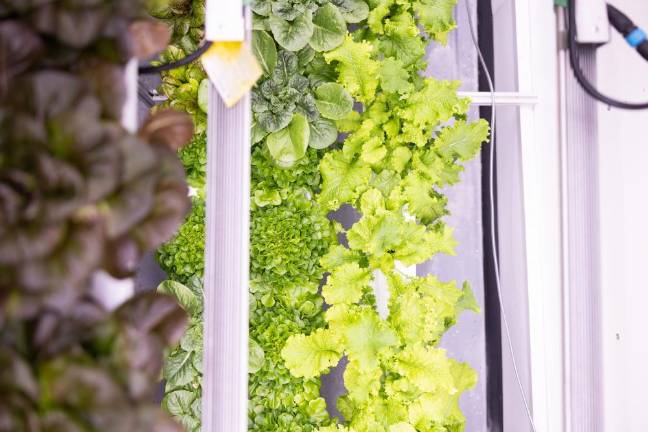
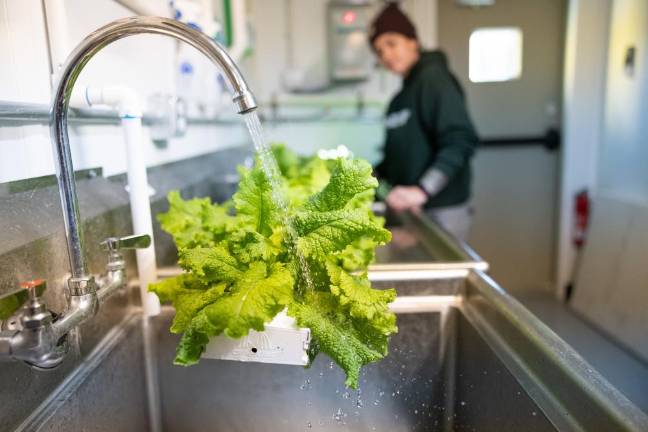
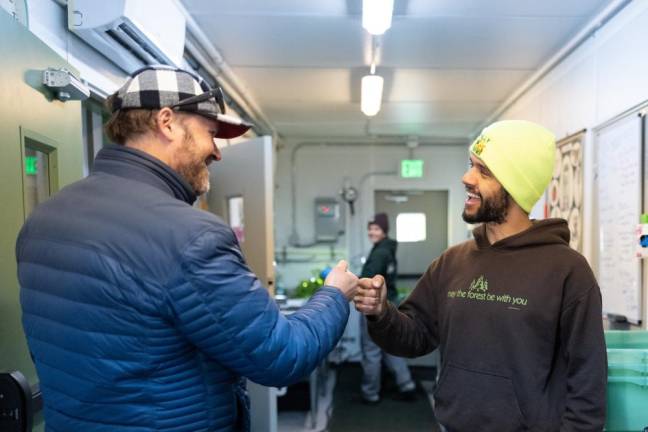
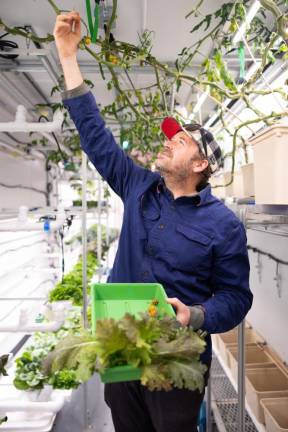
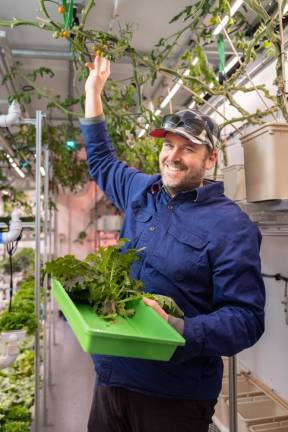
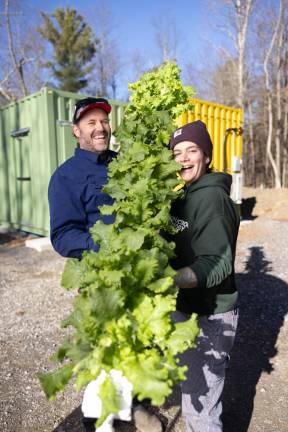
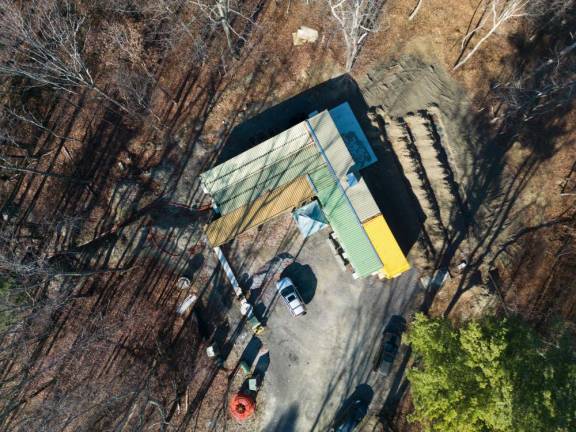
Growing up, Danny Amend spent a lot of time in the family garden in California’s Sonoma County, weeding and hauling wheelbarrows of chicken manure. It was one of the chores expected of him and his brother, but the garden became far more than that. “I loved going out there, harvesting asparagus or zucchini, as a kid thinking about what I was going to turn it into.”
Amend would go on to become “Chef Danny,” a sought-after trailblazer of the New York culinary scene. Which meant two-and-a-half decades of being stuck in a kitchen six days a week, 15 or 16 hours a day. “I was always running systems, working a station,” said Amend. “I’ve been so stuck in the food world. In the city I never had space to have a garden, never had time.”
But all that time he was stuck in kitchens, he’d been dancing around an idea. He researched a 10-foot container where his restaurant group could grow its own herbs (not in the budget). He spent a year developing the concept of an urban farm to install at an art institution, that would showcase different types of vertical farming and feed area schools (foiled by Covid). Then the pandemic shook things up, and Amend found himself back on intimate terms with leafy greens at last.
This time, the setting is a warren of shipping containers that make up Far Out Container Farm in Columbia County, NY. It doesn’t yet have an address, so Amend gives me a nearby intersection where we can meet up to caravan into the site. Overshooting my destination, I come to a dead-end where a Tesla is plugged into a docking station outside a farmhouse. Reassured that I’m in the right place, I cruise back downhill and find Amend’s SUV waiting.
He leads the way to the site, a lone outpost on a shale hillside. It doesn’t look like much from the outside. After all, these are nothing more than the cargo containers, the oversized Lego blocks hitched to every tractor trailer on the highway. It’s the inside I came to see.
Stepping out of the sub-freezing morning into the first of five containers, we enter a welcoming foyer with an armchair prominently positioned in the valuable square footage. Along with an actual bathroom with running water, it’s a hint that, unlike most farms, this one expects visitors. “I wanted to make it kind of a feel-good zone, you know,” said Amend. “I want to have it be an education center where youth can come in and maybe they’re not into working as a traditional farmer but they could be into working in these kinds of agricultural opportunities.”
We stick our heads into a walk-in cold storage containing food grown steps away, like a tub full of heads of romaine and – Amend’s favorite – salinova oak leaf lettuces. “It’s a beautiful head lettuce, it almost looks like a hedgehog to me,” he said. “As a chef, I see it as you can stuff things in between the leaves, do like a knife and fork salad.” Normally, he said, they “grow a little bit wispier, but by getting a lot of air on them they grow denser and flatter so you get these big, dinner-plate size lettuces if they’re grown right.”
Also stored here are crops grown on the larger expanse of Wally Farms, which comprises about 1,000 acres of scattered fields and a sprawling ecosystem of experimental farming projects. Wally Farms was founded in 2018 by climate-focused entrepreneur Susan Danziger, after she and her husband, venture capitalist Albert Wenger, moved up from the city to an old sheep farm in Taghkanic, NY. Amend met the couple in 2020, and they started talking climate change solutions: controlled environment agriculture, hydroponics, the very things that Amend had spent the last year researching. That’s how Far Out Container Farm became the first of the micro-businesses to be incubated by Wally – though it is now, Amend stresses, its own LLC.
True to the Wally ethos, even the containers themselves are sourced locally. They were built to spec by a mom-and-pop outfit now called Box4Grow, in a 7,000-foot warehouse in New Hampton, NY, rather than being shipped from California or Arizona, where most of these container farm companies are based. Box4Grow was founded in 2017 by a trio including husband-wife team Orca Melenbacker and Colleen Bates, of Pine Island, NY. They mostly build turn-key cannabis growing boxes these days that go for $75,000 for a 40-footer. “That’s the bread-and-butter,” said Bates, but their customers also include researchers, farmers and doomsday preppers.
Amend is far from Box4Grow’s biggest job, but he’s a strong contender for most interesting, said Bates – and on a client list with no shortage of quirky characters. “As you can see with what Danny’s doing up there and what’s happening across the globe, the idea of vertical farming for food source is just going to continue to ramp up,” she said.
Box4Grow would soon be delivering two more units to the site – the first for growing more greens, the next for fungi. Then will come a separate “wash/pack” to be created by combining a dozen 8-by-20 modular units, for washing and packing produce grown on Wally. “It’s going to be like a whole building out of mods, basically,” said Melenbacker. I mentioned that I had never heard anyone so excited about washing vegetables as Amend was in anticipation of this facility. “Probably the nicest wash/pack ever built,” agreed Melenbacker in his characteristic deadpan.
Where vegetables get washed turns out to be no small matter. When the market gardeners brought their crops inside the containers to watch them in the clean room last season, they brought along an infestation of soft scale that hit Amend’s perennials hard. His remaining Meyer lemon and yuzu trees are now languishing in a corner. It was about time to harvest everything and do a deep clean, said Amend. “I’ll probably close the doors, give this room a really strong ozone treatment to take care of any bugs that might live in here because they would suffocate.”
PLUMBING IS THE lifeblood of hydroponics, Amend explains as we step into the fertigation room, full of tanks where liquid plant food is mixed and pumped. “I love plumbing. The movement of water, it’s interesting,” he said. A separate workroom contains racks full of plumbing parts and pieces that Amend and his assistant, Kim Ducese, use to build their own fixtures and troubleshoot.
It’s a highly detail-oriented process, with no end of cleaning and note-taking – familiar territory for a chef. “That’s how I ran all the kitchens I ever worked at: keep it clean, keep it organized,” said Amend. “It’s easier to know where things go wrong if you kind of have those SOPs,” he said – spelling it out as I stand there, pen mid-air, trying to remember what that means: “standard operating procedures.”
“This is the exact same thing as creating a dish in a restaurant,” said Amend. “You’re taking all these different variables and you’re kind of nudging it along, putting a little salt here, you know, putting a little heat, a little oil, acid. I feel like the same level of care and thoughtfulness goes into the growing of the plants as into running a restaurant kitchen.”
But a hydroponic farm is also the polar opposite of a commercial kitchen in one essential way. Amend’s son, now 5, can join him. “He was there when it was just an open space in the middle of a tree clearing. He held the tape measure when I was measuring all the points so I could create the layout in the CAD [computer-aided design] program. He’s been there to help me vacuum and mop the floors when the containers were delivered. He’s there on the weekends with me when I need to come check on the fertigation systems, do my harvest,” said Amend. “Kitchens are totally different. Kitchens are like, eh, don’t touch that, that’s really sharp, or that’s really hot.”
Finally, we step into the 40-foot container where the magic happens. Ducking under a sungold tomato vine that’s wrapped itself around the container’s interior, Amend inhales deeply. “It’s kind of a blast coming in here. It’s 25 degrees outside, you come in here and you can smell the plants, it’s like mmmmmm,” he said.
He snaps off a leaf here and there from the leafy greens growing in long white trays and invites this reporter to do the same (unthinkable!). So he does it himself, offering a taste of arugula, then a mustard green. They’re full-grown, but crisp and tender down to the stem, spicy but not overwhelmingly so. I haven’t tasted the peppery snap of fresh arugula since spring in my garden. In the Northeast, when temperatures drop below freezing, we don’t have such things. Sure, you can get salad greens in a clamshell at the grocery store, but their zest will have faded in transit from California, Florida, Mexico or South America.
“I personally prefer big, dense arugula,” said Amend, rather than frilly little leaves. “So through light exposure and challenging the plant you can force them to bolt or flower, but because of the environment and the fact that you have just the running water nutrient, they don’t form the fiber, especially in the bolting parts, so you can eat the entire plant, which would normally be so woody you couldn’t touch it.”
Challenging the plant? That, he explains, means sending lots of air flow over it so that the plant grows denser and flatter. If they’re too coddled, plants grown indoors can get wispy, flabby, wilty. Amend’s lexicon is the language of the kitchen, finely attuned to these nuances. “But you can really move away from that by giving them lots of air flow, working with your light exposures, things like that.”
This is part of the “elevation of food” that is the task here. These greens have a three-week shelf life because they are free of bacterial stowaways. Eventually, they will all be uniform, dialed in to their optimal conditions, the platonic ideal of a head of lettuce.
It is a high bar, and Amend is not thrilled with the mustard greens, noting some subtle paleness on the tips. “Why are these turning yellow? We had an LED driver blow out so these plants didn’t have light for a week and a half and I think they never really recovered.”
“Me and Danny are trying to future-proof food, really, you know?” said Licurse, Amend’s assistance and another chef-turned-farmer. She specialized in meat smoking for 16 years. Licurse is harvesting lettuces while we talk, wearing blue plastic gloves for the job, which she still finds strange. “When I worked in the fields, I would never consider putting on gloves to harvest anything. But our ops are so different that you have to keep that sanitation in mind. We’re producing a final product, so you should be able to take what we’re offering right out of the bin and eat it,” she said. “That’s part of the elevation of the product: it’s consumer-ready. You can just go and munch it whenever.”
Larger plants grow in plastic bins called Dutch buckets, like the aforementioned 20-foot cherry tomato vine that’s still producing fruit in November, as it has been for six months. A hot pepper plant looks like a small tree, 15 ripe peppers and many more green ones dangling from its branches. “Normally you think of a pepper, it’s an annual. I could see this pepper plant living for years,” said Amend. “It’s on its fourth cycle of peppers already, it’s just one plant and it’s produced 400 peppers already.”
IF THIS FEELS like a precious method for growing garden-variety vegetables, that’s not lost on the crew here. “It does pull a lot of juice, because you know, your temperature control, your growing lights, things like that,” said Amend. Then there are the start-up costs, from about $60,000 for a basic 40-foot grow box up to $100,000 for a fully rigged unit like this one. But once you’re up and running, particularly if you’re hooked up to green energy, your operational expenses are low and “your grow potential is very high. Plant food doesn’t cost a lot, you’re using so little water, so then it starts to really make sense,” said Amend.
“Where it really shines is in water retention,” he said. Hydroponics uses about two percent of the water required to produce the same crops in a field. “You can grow 10,000 heads of lettuce and use 120 gallons over the entire lifecyle of those plants.” In an increasingly drought-ridden future, that feature may eventually trump all others.
Container farming is not the “be-all, end-all, obviously,” said Amend. “Some things don’t make sense” to grow this way. That hits home when the market gardener comes in with flats upon flats of cucumbers, which Amend can also grow – but why?
He focuses on thirsty crops prone to getting buffetted about in the field, crops that it makes no sense to ship thousands of miles. “Lettuces, herbs, leafy greens, stuff like that. Anything that might struggle with exterior stimuli: light exposure, temperatures, they do well in here,” he said. “It doesn’t make sense to buy your lettuce from California. It’s picked, it’s sprayed often, and then it has to travel across the country. Great, you can get kale in the winter, but the kale’s coming from Florida, and it still has to get up here.”
As much as they are farmers, Amend and Lucese are researchers, too. They’re doing a deep dive into alternative ways to grow food in anticipation of a future in which we are going to need an all-of-the-above strategy to keep ourselves fed.